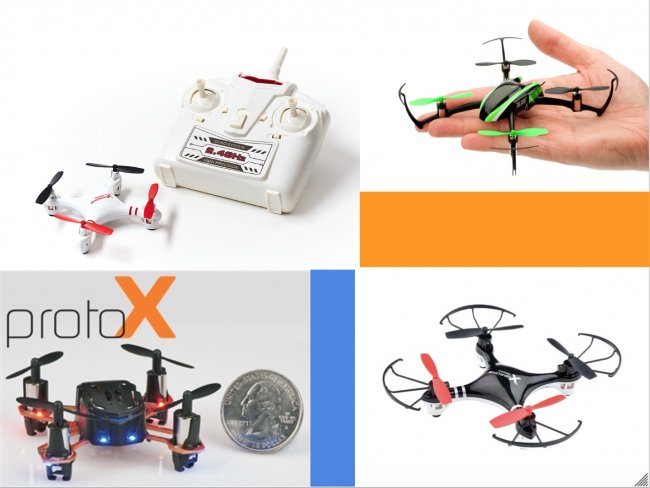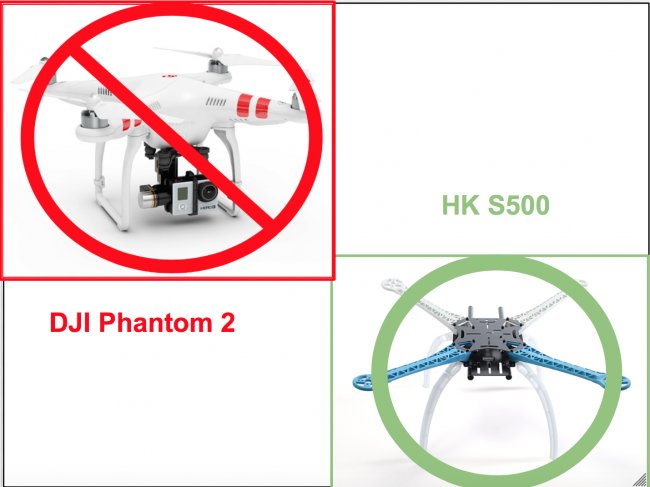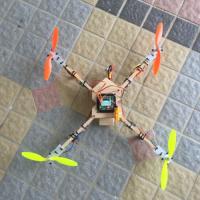After reading Red20Rc’s article ‘Surviving Dads with Drones’, I felt inspired to help the newbies among us, and give them some advice on getting into multirotors.
A Phantom Issue
First of all, I would like to criticize the market-leading power of DJI Global. Just because the DJI Phantom is reasonably affordable and well marketed, it does not entail that the product is the best bang for the buck. At all. Let me explain why.
A friend of mine received a small toy ‘drone’ for Christmas, in order to learn how to fly before purchasing a DJI Phantom 2. As much as I tried to dissuade him away from the Phantom, he stuck with his idea. This is not so much a bad thing, but these ready-made quads don’t come with much of a learning curve. So predictably, when he crashed his little quad (A 'Nano X Drone', to be precise), and he broke a propeller, his lack of knowledge of the workings of the aircraft caused him to replace the broken propeller with one that spun in the opposite direction. This obviously was a problem, as the quad wouldn’t fly, and he was left trying to figure out why. He asked me to help him, and I switched the offending prop and got him flying again, but it made me think.
He had no idea that certain props must go on certain motors, but then he also didn’t know anything else about the quad; he had no understanding of how it worked. Once he was able to fly to a reasonable standard, he would have gone on to buy the Phantom and flown it around in GPS mode until he predictably crashed it. The Nano X Drone is small, light and has prop guards, which make crashes and bangs completely harmless, so crashes become acceptable and common place. When flying the DJI, this redundancy vanishes, and when crashes occur, repairs and replacements can be expensive or difficult. The Phantom weighs a lot too; the potential damage it can cause is quite large. Even if my friend had simply broken a prop or bent a motor shaft, the likely hood of him giving up on his quad copter would be rather high, as it would seem too daunting to fix. I have another friend who gave up on his A.R Drone after a puffed battery. The thing wouldn’t work, yet he had no idea why.
Another Option
This is where the power of understanding comes into play. If one can understand how a quad works, they can understand how to fix and improve their quads, as well as giving them the ability to try building their own. This is what I recommend you to do.
If you have just bought a DJI Phantom, and you have never flown a quad before, stop. Don’t plug the battery in, or even open the box. Leave the quad where it is, and get something that you can crash. YOU WILL CRASH. So go and buy a Blade Nano QX, or similar indestructible quad, that you can bash around and learn to fly properly, and when you stop crashing into walls, you can move on.

But I still don’t recommend moving to the DJI. I recommend building. Buy a frame, make your own, buy some parts online and make your own multirotor. This will open a thousand more doors than buying a Phantom straight off. Even if you crash this, you can simply replace a boom, rebuild the frame or make the necessary improvements in order to keep it in the air. You can’t do this with the Phantom. This will allow you to get into Aerial Video, Mini-Quad racing or FPV. It will provide you with an understanding that will stay with you throughout your multirotor journey. It will pave the road to success in every field of the hobby. Don’t touch the transmitter of the DJI until you can confidently fly and you believe that it is the best quad you can buy for aerial photography. I don't mean to target the Phantom alone; any Ready-to-Fly quad that brands itself as a toy or gadget should not be treated as one.

Your scratch built quad will fly just as well, if not far better, than any ready-to-fly quad, and you can tune it to fly the way you want. Even if it isn’t the shiny white ‘drone’ that you want to show off to your friends, when someone walks up to you in the park and asks whether you made the awesome-looking V-Tail quad hanging above your head yourself, you can say; “Yes, I did.”
To finish off, here is the maiden flight of my first scratch built quad, just to prove that they do work, fantastically well.










I read until my eyes bled. I'm still learning 3 yrs later. It may be just a statement of the instant gratification society we live in today? They want it now, and they have the money to throw at it. A lot of DJI's will end up in the back of a closet and forgotten because people are to lazy to read.
Log In to reply
Log In to reply
This doesn't dispute your recommendation to start with a Nano QX, however the next step from a Nano QX wasn't going to be a scratch built for me.
Log In to reply
Log In to reply
What's it like to fly? I wouldn't mind getting my hands on one...
Log In to reply
Log In to reply
Log In to reply
I built the FliteTest Knuckle quad and find it a great platform for beginners, my 6 year old son had even flown it... I could not recommend this quad enough for a number of reasons.
1 - You learn how have to do the background research into multi rotors, how they fly and go together etc. Like that you have a good understanding before you even fly.
2 - The Knuckle quad has a good build video from Chad on the Flitetest website, follow that you'll have no real issues.
3 - For basic flying it's pretty cheap to get in the air especially if you already have a Tx system.
4 - If you do crash, you only break a wooden boom that you can get from the hardware store, no waiting for parts in the post. I usually have a couple of spare frame parts in my field kit.
5 - As you progress, the quad can progress with you, changing the board settings make it a good Acro frame, I prefer the more gentle smooth flying.
6 - It's small frame will easily fit in a case/bag for transport and storage.
7- Powerfully enough to take a GoPro for filming.
8 - Great for first FPV platform, it's what I learnt...
I build all my planes and quads from scratch mainly because I enjoy the build process and it's saves a ton of cash. Even if you are not a hardened builder, there is a quad or plane out there that will suit your skill level...
Log In to reply
Log In to reply
So now i'm at the point where i need to calibrate it but we have heavy rain and snow right now, and i don't have a large indoor area to do it :)
Log In to reply
Log In to reply
Just like learning to drive, I think learning to fly from an experienced person is a far more practical approach than saying you should be able to build before you fly. And building your own quad is no easy thing. It might be for some of us who have been in the hobby for a while, but not for a beginner flyer and certainly not for a complete newbie.
I personally feel that the more people who grab a RTF and get out there and have a go, the better it is for the hobby. Let them fly, let them crash, and those who leave frustrated - fine. But there will be a percentage who stick with it and go on to build their own multi rotors.
Best of all, grab a RTF, find an experienced flight buddy and learn.
Log In to reply
My first quad was a RTF (a flamewheel 450 clone). A mate of mine had bought himself a quad at the same time, so we learnt to fly together. That's what kept me in the hobby even after a few crashes.
He's since graduated to running an aerial photography business (they have a CASA UAV Operators Certificate, making them one of the few businesses that are actually able to do it legally) and I've moved on to flying a Blackout mini-h.
I guess the important thing is to keep people in the hobby. I didn't want anything to do with the building (soldering was scary!) side when I first started, but if you hang around long enough you get there!
PS that's what makes FT so great, it's all about the people
Log In to reply
My problem with the Phantom is exemplified by an article I read a while back. The guy who wrote the article bought a Phantom, was flying it in his back yard, it lost GPS lock, he panicked, it went over his house and crashed on the sidewalk in front of somebody. And then he wondered why it was legal for him to own such a thing rather than wondering what he did wrong. (And what he did wrong was not knowing how to fly his quadcopter.)
Before you should ever use cruise control and a navigation system in a car, you need to know how to operate and maintain control of the vehicle. And that knowing how to operate and maintain control of their multirotor is what a lot of these new Phantom owners are missing.
Is scratch building necessary to achieving that knowledge of operation and control? No, not really. But it sure does help a great deal. Someone could buy a Phantom, keep it on manual while they learn to fly, then use GPS for its intended purpose. Nothing wrong with that. But building your own really forces you to know your machine, learn how to fly it without the crutch of GPS, fix it yourself when something breaks, change the things about it you don't like, etc. It really is a much more rewarding experience.
Log In to reply
Just another option. I fully agree with this article. Wood dampens great and is cheap. Once you build your first copter, you'll be hooked. WOOD IS GOOD!
Log In to reply
I was given a Sony AS100 for my birthday but then couldn't find a Gimbal for it. I decided to buy a Walkera QR X350 since it was advertised as suitable for the Sony, it's even stated on the retail packaging. I thought the "hands off" GPS would be useful for photography, and the way it works (it does work) would have made it great except compatibility with the Sony is a lie. It's gopro or the Walkera camera, or nothing.
To complete newbies I'd actually recommend spending 30-40 bucks on a 3, or 4 channel, toy bi-rotor heli.
It's the cheapest way to get the basics and do exercises like your figure 8's and nose in. and if you're proficient with that you're ready to buy a quad off the shelf.
Log In to reply
Log In to reply
Log In to reply
Log In to reply
Log In to reply
Log In to reply
I will be progressing next to a scratch build as I really want to understand the components better. I have been reluctant to this day as I have not been confident to order all the components from the standpoint of understanding completely the compatibility of each item. I am thankful that the power packs are now available. This has lowered my activation barrier. I just need to decide on the TX and the RX.
I think however before I start with my quad build I will be exploring a Versa Wing.
Very thankful for th FT crew for helping to demystify all the components. I am so glad these resource is available.
Log In to reply